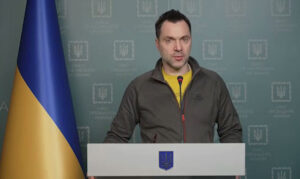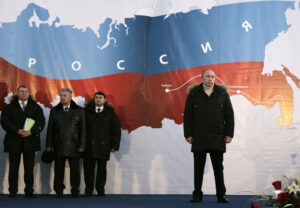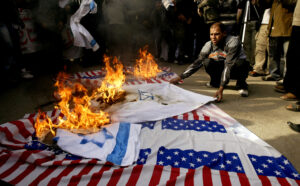“Whichever way this war ends,” thought Volodymyr Ishchenko on 24 February 2022, “I will no longer have a homeland.” In the preface to his new book, Towards The Abyss, the iconoclastic sociologist outlines his Soviet-Ukrainian identity as distinct from Ukraine’s Russian-speakers or the population of its south-eastern regions. Instead of ethnicity, these people were shaped by the forces of social revolution, class and modernisation. Looking back at the post-Soviet decades, Ishchenko argues that the political fragmentation of Soviet Ukrainians and the fragility of the “Eastern” (misleadingly called “pro-Russian”) camp in Ukrainian politics, as opposed to the politically stronger “Western” (“pro-European”) camp, is an underestimated cause of the ongoing war.
Below, we republish the second half of the preface, a blend of family memoir and national history:
***
For over 30 years, the Ukrainian nationalist intelligentsia advanced a very specific project of Ukrainian modernity. Its two main components were a rejection of Soviet modernisation and an anti-Russian articulation of Ukrainian national identity. These intellectuals sought to draw an equivalence between everything Ukrainian (in their specific articulation) and everything modern, while on the other hand they hoped to associate everything backward with everything Soviet and Russian.
In effect, they sought to reverse the symbolic hierarchy that identified Ukrainian with backwardness, which they feared existed behind the screen of the Soviet internationalist project. “Ukrainian” was to be seen as young, metropolitan, cosmopolitan, fluent in English, stylish, mobile, liberal, well-educated, successful. The “Soviet” and “Russian”, on the other hand, had to become old, conservative, provincial, rigid, clinging to dying industries, poorly or inadequately educated, in bad taste, losers.
This polarisation did not require complete homogeneity. After all, modernity is also about free rational debate. The fulfilment of Ukrainian modernity required “Ukrainian feminists”, “Ukrainian liberals”, “Ukrainian Leftists” — as well as Ukrainian Rightists. Of course there should be discussion of the nationalist crimes of the Second World War (with the obligatory disclaimer that the Soviets were worse). Of course there should be concern about Right-wing violence today (with obligatory disclaimers that it benefited Putin). And so on and so on. But at the critical moments when these discussions could really matter politically, and not just appease the “enlightened” conscience, all the red lines were strictly enforced, and you had to get back in line. Or get in trouble.
I was so much like these people. We had so much in common in our biographies. We went through the same universities, the same scholarships, the same programmes, the same civil-society institutions, the same conferences. We spoke the same languages. But I had not begun to think like them. My peer group often reacted to this with hatred. In one trashing of me by nationalist intellectuals, I was portrayed as a danger to the dear cause of the “Ukrainian nation-building project”. It was not because of what I wrote: they typically did not engage in any substantive discussion. And regardless of what I could possibly write, there were so much stronger forces in the media and politics that any imaginable “threat” I posed was negligible. No, it was certainly not what I did that threatened the nationalist cause, but, I think, simply the existence of people like me. We could challenge the national-liberals as social equals in forums. We were an unwanted nuisance to their monopoly. Not really traitors to an imagined community, but traitors to a real existing social group. Class traitors, not national traitors.
Here was the real hatred. We were Ukrainian and modern, but not like them. Soviet Ukrainians who could have become comprador intellectuals in a peripheralising country, but refused this role. We resisted their collective gaslighting. That is why there was no rational engagement, only denial, silence, rejection, cancellation. One could write thousands of words against Russian imperialism and yet still be called a “troubadour of the empire”. One could literally say “I hate Putin” and still be accused of spreading Russian propaganda. Our intellectuals were not rated as intellectuals. Our scholarship was not scholarship but “political activism”. The political repression against us was not political repression, because threats and violence allegedly never occurred. We were simply not allowed to exist, because, if we did exist, the specific articulation of modernity and backwardness in Ukraine would no longer work. Whatever we did, we could not simply be.
We were potential embryos of an alternative Ukrainian modernity, one that could build an “organic” representation for Soviet Ukrainians — for what they were, not for what they were “supposed” to become in the view of nationalist intellectuals; that is, to become like them or to disappear altogether (at least from Ukraine’s public sphere). We could offer an alternative for Ukraine that could also be more appealing globally and in line with future trends, or at least with what more and more young people around the world would prefer as their future.
Why didn’t it work out this way? Many have compared the post-Soviet conflicts with the collapse of empires of the past: new contested borders were drawn; ethnonational groups that were part of the imperial majority became minorities in the new states; groups that were formerly oppressed minorities were given opportunities for revenge. These comparisons are typically blind to social class and revolutionary dynamics, which provide a very different perspective.
For example, the political crises and conflicts that followed the collapse of the great European empires after the First World War were fundamentally different to those that followed the demise of the multinational Soviet Union. The post-Soviet crisis was the terminal crisis of a social revolution, not an ancien régime. The new nationalisms of a century ago blossomed in the context of modernisation, not de-modernisation. The Twenties and Thirties were a period of intense politicisation, when organised revolutionary workers fought against no less committed and organised fascist counter-revolutionaries. The post-Soviet years, by contrast, were a period of atomisation, of general apathy, disturbed only by short-term maidan mobilisations. In sum, the post-WW1 crisis was a stalemate of strengthening social forces, while the post-Soviet crisis was a stalemate of mutual weakness.
As noted above, the pro-Western intellectual and civic elites in post-Soviet Ukraine could offer nothing comparable to Soviet modernisation. The majority of Ukrainians did not buy their dubious promises that they too could join the global middle class. But the Russian elite’s offer was even less attractive. They typically compensated for their weakness in soft power with hard power. But even when they resorted to escalating coercion, they exposed their profound weaknesses.
There were three critical moments when the Ukrainian majority broke away from Russia, ending up further removed from its orbit on each occasion. Each of these was related to the failure or mid-course correction of military coercion initiated by the Russian elite. Ukrainians responded to the failed coup in Moscow in August 1991 by voting for independence, only eight months after having voted to preserve the Soviet Union. In response to Russia’s annexation of Crimea and the start of the war in Donbas in 2014, support for Russia-led reintegration projects became limited to a small minority in Ukraine, whereas they had previously been able to claim a majority or at least a plurality. The full-scale invasion in 2022 provoked the strongest anti-Russian consolidation in Ukraine ’s history.
These massive reactions to Russian coercion were purely negative in nature — rejections of what Russia was doing, rather than support for the West or for Ukrainian ethnonationalism. However, it was the “Western” camp that was able to seize the opportunity of these negative shocks to advance the positive substance of its agenda. This happened because of the profound class and political asymmetries between the “Western” and “Eastern” camps. The political capitalists of the “Eastern” camp did not develop their own civil society and Soviet Ukrainians remained too atomised to build their organic representation from below. Their plebeian “anti-maidans” were never a match for the maidan protests they were responding to. If Volodymyr Zelensky’s landslide victory over Petro Poroshenko in 2019 — after the incumbent ran on an aggressive nationalist programme — offered a last hope, this was dashed by the 2022 invasion.
As a result of the failure to develop and defend a pluralist nation-building project that would “organically” grow from the Soviet Ukraine, a large group of Ukrainians is now becoming the object of assimilation policies, squeezed between the “Western” nation-building projects of Ukrainian bourgeois civil society and Putin’s nostrum of “one and the same people”. In his notorious 2021 essay “On the Historical Unity of Russians and Ukrainians”, Putin articulated the Ukrainian-Russian distinction as a difference of regional-cultural variety within the same “people” as a political unit. However, there is in fact less of a cultural difference between the population of the urbanised and mostly Russian-speaking south-eastern Ukraine and the Russians, and more of a political difference.
The urban culture of the late Soviet period, with its largely homogeneous cuisine throughout the USSR, typical references and jokes from literature and cinema, rituals and holidays, is far more relevant to them than the pre-modern ethnic traditions of Ukrainian and Russian villages. If some of the previously Russian-speaking Ukrainians switched to Ukrainian as a reaction to the invasion, it was clearly a political choice for them, not determined by their ethnic identity. The people feel more connected to the national imagined community of Ukraine, and less to Putin’s, even if they have a different vision of the nation than the speakers of the “Western” camp. In 2016, only 26% of Ukrainians agreed with the statement that Ukrainians and Russians are “one and the same people”, although 51% agreed that Ukrainians and Russians are different but “brotherly people”.1 Both figures are likely to have fallen dramatically after 2022.
For the “Western” camp, the weak cultural difference of some Ukrainians from Russians has always been a political threat. It was seen not only as legitimising Russian expansionism, but also as a threat to their elitist ersatz-modernisation project. Quite early after the Russian missiles hit Ukrainian soil and Russian troops crossed the border, the national-liberal intellectuals understood that this was not only a threat, but also an opportunity for “knife solutions” — a radical, uncompromising transformation of the whole country in their image and likeness on a scale that was impossible before: the war helps to silence the voices of discontent.2 The substance of “decolonisation” was not the building of a stronger sovereign state with a robust public sector — one that would contradict transnational capital, their crucial partner.
Rather, it was the eradication of anything related to Russia or the Soviet Union from the Ukrainian public sphere, including the removal of Russian-language books from libraries, the ban on teaching Russian in schools, even in predominantly Russian-speaking cities like Odessa, and even a ridiculously obscurantist attempt (which passed the first reading in the Ukrainian parliament) to ban the citation of Russian and Russian-language sources in science and education. Add to this the banning of political parties, including some of Ukraine’s oldest, such as the Socialist and Communist parties, which have represented the “Eastern” camp for decades, and further repression of popular opposition media and bloggers stigmatised as “pro-Russian”, even when they expressed no sympathy for the invasion. Ironically, the result is similar to the situation of Ukrainians in the pre-revolutionary Russian Empire: not so much discriminated against as individuals, but prohibited from expressing a distinct collective identity that would be seen as treasonous and repressed.
In Ukraine, we can’t be Soviet anymore. In Russia, it does not look like we can be Ukrainians. Soviet Ukrainians were the product of a social revolution; its degradation destroyed them as a political community. First, the late Soviet and post-Soviet leadership became seen as nothing more than a corrupt, self-serving elite. The atomised masses responded with frequent but poorly organised and amorphous protests that, when successful, only reproduced and intensified the underlying crisis. Unlike social revolutions, the maidans did not bring radical transformations in favour of the popular classes; they typically only increased social inequality. The maidan revolutions did not even build a stronger state but only destabilised the existing one, allowing domestic and transnational elite rivals to seize the opportunity to advance their interests and agendas. The post-Soviet elite responded only with more coercion, which eventually escalated into war (see how it worked out with the successful repression of the 2020 uprising in Belarus). This set the stage for the flourishing not of developmental national ideologies but of regressive neo-tribalist identities. There was no strong force from below to counteract this dynamic. The processes of the escalating crisis of hegemony are universal, but their manifestations in the post-Soviet space are of a rather unique magnitude.
The decomposition of a political community is the ultimate endpoint of these crisis trends. Divided by frontlines and borders, some volunteering, some being mobilised by force, some collaborating, some fleeing abroad, some trying to maintain a normal life and work in their hometowns, some simply trying to survive, taking different positions on the war (who even cares what “Ukrainian voices” who speak from Donetsk or Sevastopol think?), lacking our political and public representatives, with limited space for expression, with broken ties and suppressed discussions — is there even a common name, a claimed identity for all of us now? It is easy to pretend that we have never even existed, at most a dead-end branch from the main line of Ukrainian nation-building. But one can be sure that without a new cycle of modernising development in Ukraine, Soviet Ukrainians will not be fully assimilated. The political communication required to define our common identity, interests and collective actions in relation to Ukraine, and the states where we will end up, may start again.
The revolutionary project initiated by the Bolsheviks a century ago is no longer embedded in the national communities where it once took root. For the contemporary Left, this should mean not a break with the project of progress, rationality and universal emancipation, but rather the search for a political (and perhaps no longer national) community in which our efforts could be more effectively applied. Any new social revolution would learn from the Soviet one as much as the Bolsheviks learned from the French Revolution of 1789 — understanding its limits and acknowledging its (sometimes unjustifiable) mistakes, but also registering and building on its achievements.
Could Ukraine again be a core part of a social-revolutionary movement? The extent of the ethnonationalist and anti-communist reformatting of the country’s politics, society and ideology may leave no hope for this in the foreseeable future. But consider how dramatically the memory of the Second World War has changed over time. Who could have imagined in 1945, after the Nazi war of extermination and enslavement on the Eastern Front, which murdered between one-sixth and one-quarter of the entire civilian population of Ukraine, that the descendants of the survivors would fight using German tanks against Russians on the very same battlefields where they had fought in the Red Army against German tanks, and would do so while demolishing the remaining monuments to their heroic ancestors? It is unlikely to be the final ironic twist of Ukrainian history.
FOOTNOTES
- “Konsolidatsiia ukrainskoho suspilstva: shliakhy, vyklyky, perspektyvy” (Consolidation of Ukrainian society: Paths, challenges, prospects), Razumkov Centre, 2016, p. 71.
- S. Rudenko, ‘Spetsoperatsiaa “Derusyfikatsiia.” Interviu z holovnym redaktorom Istorychnoi pravdy Vakhtanhom Kipiani’ (Special operation ‘Derussification’: Interview with the editor-in-chief of Istorychna pravda Vakhtang Kipiani), Ukrainska Pravda, 25 April 2022.
Disclaimer
Some of the posts we share are controversial and we do not necessarily agree with them in the whole extend. Sometimes we agree with the content or part of it but we do not agree with the narration or language. Nevertheless we find them somehow interesting, valuable and/or informative or we share them, because we strongly believe in freedom of speech, free press and journalism. We strongly encourage you to have a critical approach to all the content, do your own research and analysis to build your own opinion.
We would be glad to have your feedback.
Source: UnHerd Read the original article here: https://unherd.com/




